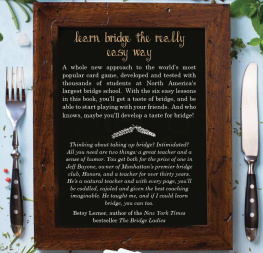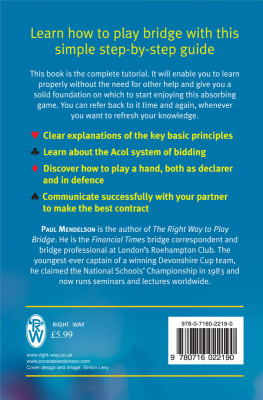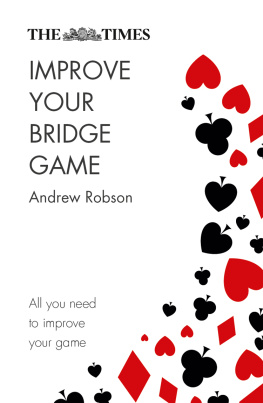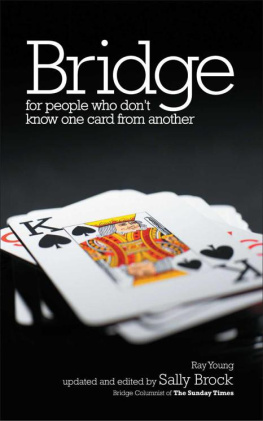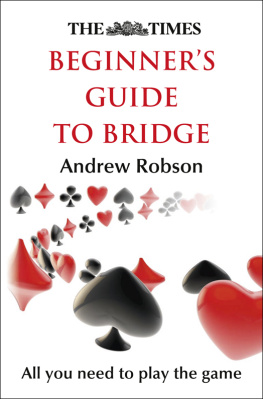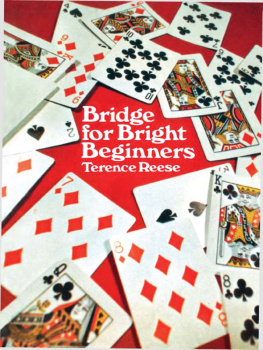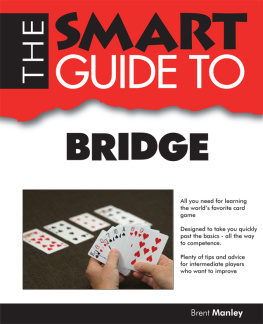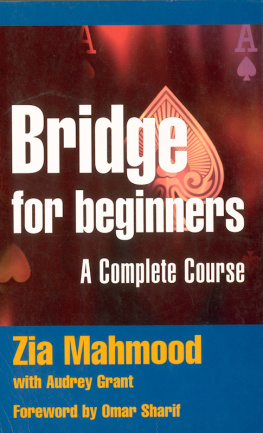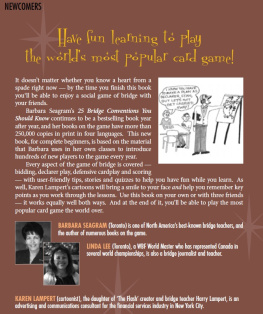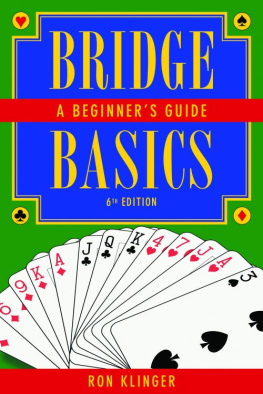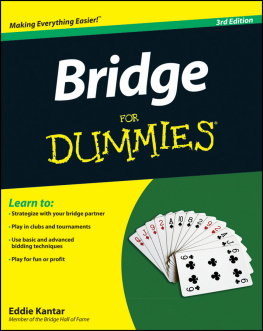



A taste of Hagen Dazs (or Ben & Jerrys) ice cream.
A taste of the good life.
A taste of Heaven.
A taste of your own medicine.
A session of bridge is usually all of these. An individual hand takes between five and ten minutes to play. Every hand is an adventure, and it happens so fast. A champion on one, a goat on the next. Sometimes a taste of Heaven, sometimes not. Bridge is fast-paced, exciting, and takes no prisoners; its the perfect game for these times.
Youre almost there. Its a big step, getting involved in something brand new. Let me tell you how Betsy Lerner, in her book, The Bridge Ladies , described her first foray into the game. It was when she attended a class at her local bridge club. Her words: I was nervous and full of anxiety and went home thoroughly discouraged and completely energized. But I also had fun, felt stimulated. I felt an immediate affinity for the game. The local bridge club she attended was our club. My wife and I taught her.
There must be dozens of books for people who want to learn to play bridge. How do you decide if this is the one? Is this the book for you? A Taste of Bridge is Honors Bridge Clubs beginner course. Its been tinkered with, kicked around, and field-tested for over thirty years. It has introduced thousands to the game. The course is fun and it works! It has helped build Honors into the largest-ever bridge club in the country.
I rest my case.
Youve probably heard a friend say something like, Oh, bridge is so complicated. Well let me assure you, it is! Its complicated but not hard. There are just so many parts to the game. Each on its own is easy. Its the putting it all together thats the complicated part. Ive uncomplicated it as much as possible and done it, I hope you will agree, in a very readable way.
Skim the first few pages. If you like the feel, the approach and the explanations, know thats what you will be getting throughout the book. I took great pains to build slowly and carefully, to ensure that your foundation is as solid as possible, and, especially, to make certain that I would not be losing you along the way.
The book is made up of lots of short chapters. Twenty-eight in all. Reading two or three chapters in one sitting (while youre on your way home, perhaps) should take less than an hour. Thats how it was designed. Two weeks on the train and youll be a bridge player.
Not!
Youll be just about where you would expect yourself to be had you decided to take up the piano, or Chinese, or tennis. I would hope that somewhere, early on, youd begin to be awed at bridges beauty and logic. Its a winning combination. After that, the rest, from my perspective, is easy.
Here is a breakdown of how I see you working on the book.
Session | Chapters |
| 1 - 3 |
| 4 - 5 |
| 6 - 7 |
| 8 - 9 |
| 10 - 11 |
| 12 - 13 |
| 14 - 16 |
| 17 - 18 |
| 19 - 21 |
| 22 - 23 |
| |
| 25-26 |
| |
Twelve practice hands follow in Chapter 28.
Perhaps you already know that Bill Gates and Warren Buffett dont generally have time for games, but bridge is the exception. Do you happen to share their taste for bridge?
Lets find out!
Jeff Bayone
June 2017



Thinking back to your carefree childhood days, do you remember playing a card game called War? For those of you who never heard of the game, or if you cant remember that far back, this is how it would have gone:
A deck of cards was split in two, half was placed face down in front of you and the other half placed face down in front of your buddy. You would each then pick the top card from your pile and turn it over. Whoever had the higher card would win. The winner would take the two cards and put them at the bottom of his pile. You didnt know it at the time, but the two cards, one contributed from each player, constituted a trick . There are fifty-two cards in a deck, therefore twenty-six tricks. The game ended when someone won all the cards by taking tricks.
Like War, bridge is a game of tricks. But unlike War, in bridge you get to see your cards before you play them and you decide for yourself which card to play. Its no longer just plain luck that wins tricks. Planning, vision, common sense, logic, experience, and even imagination, now all play roles in determining the outcome.
It takes four people to play bridge. Each trick consists of four cards. With fifty-two cards in the deck, that means there are thirteen tricks in the game. The object of the game, in its most basic terms, is to win as many tricks as you can. A bridge hand ends when all thirteen tricks have been played.
Before we go any further, its not a bad idea for you to get a deck of bridge cards or poker playing cards if you must. Bridge cards are the same as poker playing cards except they are smaller in size. This makes it easier to hold and view thirteen cards at one time.
Basic Terms
Lawyers, cooks, the police, musicians all have their own unique language. It should come as no surprise that bridge players do, too. Lets listen to one of them discussing a hand played earlier in the day:
Remember board six? Your LHO doubled you in four hearts. I believe you held stiff queen, ace king sixth, four baby, king-jack tight. You dropped the doubleton queen of diamonds offside to make an overtrick! Dont you think his partner should have pulled to four spades?
Yes, we really do talk that way. And soon you will too.
Lets begin.
Well start with a few basic terms. In a standard deck of fifty-two cards, there are four suits: spades, hearts, diamonds, and clubs. Each suit consists of thirteen cards. Lets examine one suit, say diamonds. Spread them out. Notice that some of these diamond cards have diamond spots in the center. The two, for example, has two diamond spots, the three has three spots, etc., all the way up to the ten, the highest one of these numbered cards, which has ten spots. Now, whether these spots happen to be shaped like spades, hearts, diamonds, or clubs, do you know what we call these cards? Spot cards ! (Did you really think this was rocket science?)
Next come three cards with faces on them the jack (J), the queen (Q), and the king (K) the face cards . The ace (A) is simply the ace and it is the most powerful and highest-ranking card in the suit. In order of strength, strongest to weakest, we have the ace, the king, the queen, the jack, the ten, the nine, etc., all the way down to the lowly deuce (the two). The ace beats any other card in the suit, the king beats every other card but the ace and so on down to the two, which loses to every card in the suit. The five highest cards, the ace, the three face cards, and that highest spot card, the ten, hold an esteemed position. They are your honors , as in our clubs name, Honors Bridge Club.

